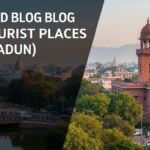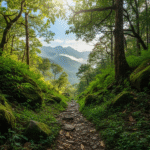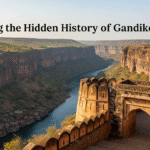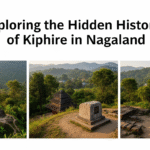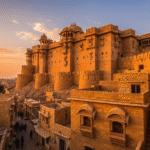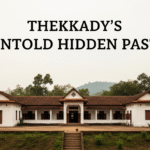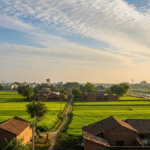Did you know Bikaner is home to more than 4,000 temples? This shows its deep spirituality. Located in Rajasthan, India, it’s full of history and culture. Bikaner uncovers stories and hidden spots that are part of Rajasthani traditions. The city is known for its amazing buildings and tasty food. It’s like a chest full of treasures ready to explore.
When you learn about Bikaner, you find cool things. You learn about its history, festivals, and yummy food. Check out Bikaner history. Knowing about Bikaner helps you love its culture even more.
Key Takeaways
- Bikaner has a rich tapestry of over 4,000 temples.
- The city is known for its unique festivals and celebrations.
- Bikaner’s cuisine offers a distinct mix of traditional flavors.
- Architectural marvels like Junagarh Fort showcase its history.
- The craftsmanship of local artisans reflects the city’s heritage.
Introduction to Bikaner
Bikaner is a lively city in Rajasthan, known for its unique desert sights. It was founded in 1488 by Rao Bika. Its beautiful architecture and royal history draw people in.
This city is surrounded by the Thar Desert. It offers a variety of attractions, from old forts to busy markets.
In Bikaner, the streets are full of Rajasthani traditions. You can dive into markets and try local foods. The city perfectly mixes history and the present day.
Unknown Facts about Bikaner
Bikaner lies in the Thar Desert’s heart. It has a rich cultural history. Yet, many people don’t know its impact on Rajasthani culture. The city’s colorful clothes and folk music are key. They show the real Bikaner. Learning about these unknown facts about Bikaner helps uncover its deep culture.
Unique Contributions to Rajasthani Culture
The Bikaner culture stands out for its dress and music. Locals wear bright turbans and clothes with beautiful stitching. This shows the area’s creativity. Folk music is essential in their celebrations. It has lively beats and touching words that tell of history and myths.
Unusual Festivals Celebrated in the City
Bikaner’s festivals are unique and show the city’s heart. The Karni Mata Fair is one special event. Thousands come to honor goddess Karni Mata here. The fair mixes Bikaner traditions. You see dance, try local food, and see rats held in high regard at the Karni Mata Temple. These events highlight Bikaner’s rich culture and bring its people together.
| Aspect | Description |
|---|---|
| Traditional Attire | Colorful turbans and embroidered garments |
| Folk Music | Vibrant rhythms narrating historical tales |
| Main Festival | Karni Mata Fair |
| Key Attraction | Karni Mata Temple, known for its revered rats |
A Brief History of Bikaner
Rao Bika founded Bikaner in 1488. It’s known for its rich history. The city started as a fort for merchants in the desert. It soon became important for trade.
Over time, several dynasties ruled Bikaner. This includes the Rathors and others like the Gurjaras and the Bhatis. These groups left their mark on Bikaner. The Junagarh Fort shows the city’s amazing architecture.
There are old findings here from the Harappa period. Bikaner is famous for its camel research farm. It leads the world in this field. The International Camel Festival here attracts many visitors.
Bikaner also celebrates festivals like Gangaur and Teej. It’s known for beautiful silver jewelry. The Gajner Wildlife Sanctuary offers a chance to see diverse wildlife.
The weather in Bikaner can be extreme. Summers can get above 45 degrees Celsius. Winters can be very cold. The city has unique baoris. They show how Bikaner manages its water.
Bikaner’s past offers insight into Indian society’s evolution. Many tribes and clans influenced its culture. Knowing about this history helps us appreciate Bikaner’s landmarks and culture.
| Year | Event |
|---|---|
| 1488 | Foundation of Bikaner by Rao Bika |
| Annual | International Camel Festival held in January |
| 15th Century | Establishment of Bikaner as a trading hub |
| Modern Era | Recognition of Bikaner for its cultural festivals |
Bikaner’s Architectural Wonders
Bikaner is home to many amazing buildings that tell stories of the past. The city’s architecture shows the impact of different times in history. You can see this in Junagarh Fort and many beautiful temples.
The Legacy of Junagarh Fort
Junagarh Fort is a big part of Bikaner’s history. Built in the 1500s, it mixes Rajput and Mughal styles. It has huge walls, fancy gates, and detailed carvings. It’s a key place in Bikaner.
Inside, there are big courtyards and halls. They let us see the rich history and architecture of Rajasthan. It’s well kept and welcomes everyone to explore.
Insights into the Temples of Bikaner
The temples in Bikaner make the city feel holy. Two famous ones are the Karni Mata Temple and the Jain Temple. They’re known for beautiful designs and importance in culture.
These places are for praying but also show off local art skills. They draw in visitors with stories and design details. These temples add charm to Bikaner, making it special for tourists.

Bikaner Cuisine: A Taste of the Desert
Bikaner cuisine gives a special food journey. It’s linked to its place on the map, the Thar desert. The weather here affects what food is made and how. The tastes are full and varied, mixing old ways and new ideas. This makes Bikaner food yummy and important for local culture.
Signature Dishes Everyone Should Try
Bikaner is known for some amazing dishes. These highlight the local taste. They include:
- Bikaneri Bhujia – A crunchy snack made with gram flour and spices.
- Kachoris – Fried pastries with spicy fillings, served with zesty sauces.
- Rajasthani Thali – A plate with many vegetarian dishes that show local favorites.
- Ghevar – A sweet dish loved at festivals and special times.
The Influence of Local Traditions on Food
The food in Bikaner is tightly linked with its traditions. Local foods come from the tough desert around. Old cooking ways passed down show how important eating together is. Food is the star at big and small get-togethers.
Cooking in Bikaner covers everything from big feast for festivals to everyday spicy meals. This mix of food and culture shows the region’s rich background. It keeps Bikaner eating traditions alive at gatherings.
| Dish | Main Ingredients | Flavor Profile |
|---|---|---|
| Bikaneri Bhujia | Gram flour, spices | Crispy, savory, spicy |
| Kachoris | Flour, lentils, spices | Crunchy, spicy |
| Rajasthani Thali | Various grains, lentils, vegetables | Rich, diverse |
| Ghevar | Flour, sugar, ghee | Sweet, festive |
Exploring Bikaner’s Traditional Crafts
Bikaner is known for its cultural beauty. It’s a place where traditional crafts tell a story. The city’s crafts show off the talent of its artisans. They keep old ways alive. This dedication ensures Bikaner’s traditions flourish.
Expert Artisans and Their Skills
Artisans in Bikaner are skilled in many crafts. They weave, make pottery, and do lacquer work. They have spent years perfecting their skills. Their work shows their commitment to quality.
This talent supports the local economy. It also keeps ancient techniques alive. The artisans pass these skills to the next generation.
Handicrafts that Reflect Bikaner’s Heritage
Handicrafts in Bikaner capture Rajasthan’s spirit. Visitors can find:
- Intricately designed silver jewelry, showcasing local craftsmanship.
- Miniature paintings from the Bikaner School of Art, each telling a story.
- Bharatdori ropes, important for agriculture and decoration, showing years of innovation.
Each item is useful and reflects Bikaner’s culture. These crafts foster community connections. They position Bikaner’s artisans as guardians of tradition. These traditions combine history with the present.
Hidden Gems: Lesser-Known Landmarks
Bikaner is filled with history and culture. It offers attractions that are not widely known. These hidden gems give a unique look at Bikaner’s heritage. They show lesser-known spots that capture the essence of Rajasthan.
Off-the-Beaten-Path Attractions
The Laxmi Niwas Palace is one lesser-known spot. It’s a beautiful example of Indo-Saracenic architecture. Built for Maharaja Ganga Singh, it has gardens and detailed interiors. Visitors love its beautiful design and the quiet it offers away from the city.
The Ganga Government Museum is another unseen treasure. Many tourists miss it. This museum has artifacts like sculptures and paintings. They tell about Bikaner’s history and culture. It’s a great way for visitors to learn about the city’s art.
Discovering these places in Bikaner can really show you what the city is about. Each spot has its own stories and designs. They add to Bikaner’s cultural story. You can also find small temples and forts, for more unique experiences.
Bikaner’s Festivals and Celebrations
Bikaner festivals are full of culture and excitement. The annual Camel Festival is a big event that brings people from around the world. It highlights the bond between camels and their owners with contests and shows. Every January, the Camel Festival is a main attraction in Bikaner.
The Gangaur Festival honors goddess Parvati. It happens in March or April. Bikaner’s traditions shine during this time with dances and colorful clothes. The city is lively, with art and crafts everywhere.
Bikaner’s Holi festival is famous for fun water and color fights. It shows the togetherness of the community. Songs and rituals fill the streets, making everyone happy and united.
These festivals are important to Bikaner’s heart and history. They show the rich culture of this city and its people. Bikaner’s traditions come alive during these times.

Bikaner Tourism: What to Expect
Bikaner travel is full of history, culture, and tasty food. It will wow fans of architecture with beautiful forts and palaces. The city is lively with festivals and events, offering unique experiences. When planning a Bikaner trip, it’s good to consider the best visit times and tour options that match your interests.
Best Times to Visit
Visiting Bikaner is best from October to March. The weather is cool, making outside activities pleasant. This time also has many local festivals, making your trip more special.
- October to March: Best weather conditions
- Local festivals enhance cultural experience
- Summer (April to June): Very hot, best avoided
Tour Packages Tailored for Bikaner
Different tour packages help travelers plan their best trip. Each one is designed for various interests.
| Tour Package Type | Highlights | Duration |
|---|---|---|
| Cultural Tour | Visit local forts, temples, and participate in traditional festivals | 3-5 Days |
| Culinary Tour | Taste local cuisine, cooking classes, and street food tours | 2-4 Days |
| Heritage Tour | Explore Bikaner’s architectural wonders and historical sites | 5-7 Days |
Conclusion
This Bikaner review shows it as a hidden gem in Rajasthan. It mixes history, culture, and food well. Bikaner is known for its crafts, textiles, and camels. It’s a must-see for those who love new experiences. You can enjoy Teej Festival, see amazing craftwork, and try tasty food.
Bikaner’s architecture shows its rich past. You’ll see great forts and old temples. You can also find beautiful lakes and a wildlife sanctuary. This city is growing fast, with a strong economy and agriculture. Everyone is welcome to try camel safaris, see stunning places, and enjoy the friendly people.
Visiting Bikaner lets you make memories to cherish. It has surprises and a deep culture to explore. This city attracts those looking for adventure or a peaceful getaway. Bikaner offers a unique trip you won’t forget.
FAQ
What is the historical significance of Bikaner?
Rao Bika founded Bikaner in 1488. It has a royal and trade-rich history. This makes it a key cultural and economic spot in Rajasthan.
What unique traditions are celebrated in Bikaner?
The Karni Mata Fair is a unique tradition in Bikaner. It features local culture, bright clothes, folk music, and shows community spirit.
What are some must-visit landmarks in Bikaner?
Must-see places include Junagarh Fort and Laxmi Niwas Palace. Ganga Government Museum also shares the city’s beauty and history.
What culinary delights can one experience in Bikaner?
Bikaner is famous for its tasty Bikaneri Bhujia and sweets. Its food is full of rich flavors that reflect the desert area.
How do Bikaner’s festivals reflect its culture?
The Camel Festival and Holi show Bikaner’s culture and unity. These events have colorful rituals and music, making them joyfully Rajasthani.
When is the best time to visit Bikaner?
Visit Bikaner from October to March. The weather is nice, and local festivals make the trip even better.
What types of handicrafts are prominent in Bikaner?
Bikaner is famous for beautiful handicrafts. This includes weaving, pottery, and lacquer work by skilled locals. These crafts tell of the city’s artistic past.
Are there any lesser-known attractions in Bikaner worth visiting?
Yes, places like Ganga Government Museum and secret temples offer unique peeks into Bikaner’s rich culture.
How does Bikaner’s cuisine reflect its cultural identity?
Bikaner’s food shows its culture with special dishes and cooking ways. It uses local ingredients, making meals key to gatherings.

